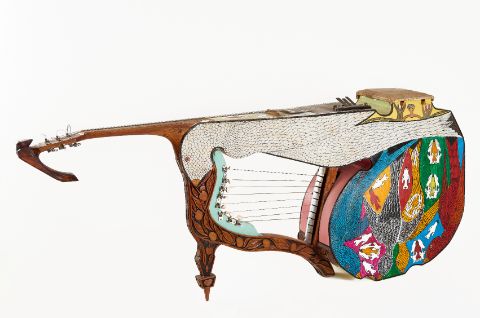Everald Brown

Starry Harp (Instrument for four people). Foto: Courtesy National Gallery of Jamaica
As a self-taught artist belonging to the Ethiopian Coptic Orthodox Church, Everald Brown’s practice spans sculpture, carving, and painting and is often closely tied to his spiritual values and beliefs as a practising Rastafarian. Brown worked as a carpenter and tried his hand as a musician, both endeavours that were mediated by Rastafarianism and reggae. Consequently, his art referenced older Jamaican cultural movements such as Revivalism and Kumina, which drew upon the rituals of both Christian and West African faiths. In Mystical Signs, for example, the artist evokes a compass or a dart board. This circular form is divided into yellow, red, green, and black sections—colours that reference the Jamaican flag (black, green, and gold), the pan-African flag (red, black, and green), as well as the Ethiopian flag (green, yellow, and red). Flanked by four bays of blue, the circle appears to be waterborne, as if floating upon an ocean. Taking this further, the round form can also be read as an island or a ring; a metaphorical take on Rastafarianism or spiritualism as a lifebuoy or a site of refuge, offering orientation, rest, and retreat.
Works in the exhibition: Cotton Duppy Tree (1994), painting, mixed media on canvas, 82 × 62 cm; Ethiopian Apple (1970), painting, oil on canvas, 63.5 × 90 cm; Mystical Signs (1994), painting, oil on hardboard, 120 × 120 cm; Dove Harp (c. 1973), instrument, metal painted plywood, wood, plastic, H: 64.5 cm; Starry Harp (Instrument for four people) (1986), instrument, metal painted plywood, wood, plastic, H: 73 cm. Courtesy of the National Gallery of Jamaica, Kingston